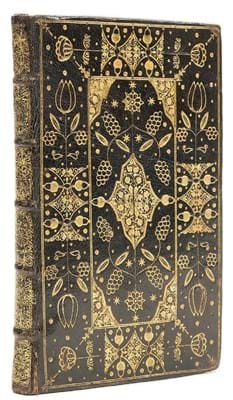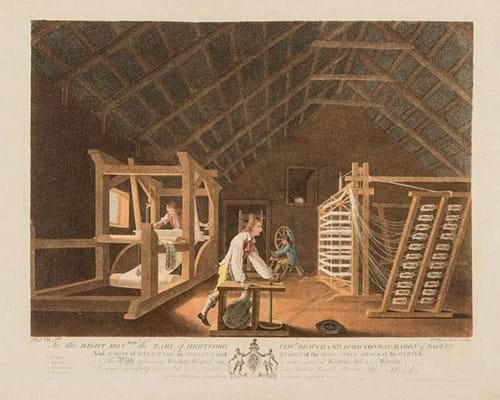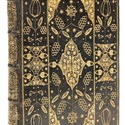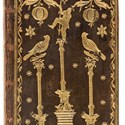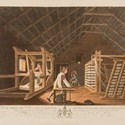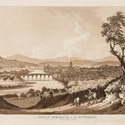The Forum Auctions (15/20/12 buyer’s premium) sale opened with around 100 lots from the estate of James Steven Cox (d.1997), who had in his time been a wigmaker (the family business), bookseller, archaeologist and publisher.
This section included two of the manuscript recipe books featured in ATG No 2336, but another attraction was a collection of playbills relating to Dickens’ theatrical ventures.
Sold at £2200 was an 1855 playbill for the first staging of Wilkie Collins’ melodrama The Lighthouse. It was performed at “The Smallest Theatre in the World” – Dickens’ home, Tavistock House – with both writers in leading roles.
A playbill for the 1857, first public performance of Collins’ The Frozen Deep made £4000. It was staged at the Gallery of Illustration in Regent Street in remembrance of Dickens’ friend Douglas Jerrold and was one of the many ways in which he set about raising money for Jerrold’s widow and family.
Dickens’ own copy, this playbill bears some alterations to the programme and, on the back, his autograph cast list for a supporting production of ‘Uncle John’.
Vampire meets Byron challenge
Byron’s challenge to his companions at the Villa Deodati to write a horror story famously gave birth to Mary Shelley’s Frankenstein, but a fellow guest, John Polidori, came up with The Vampire.
Disbound and lacking the advertisements, an 1819 first in the Cox property sported a second issue title-page, one from which Byron’s name had been removed at the poet’s insistence. That copy made £1900, but bid to a treble-estimate £3000 was a disbound example of a pirated edition of the same year – one in which Byron is still wrongly named as the author.
From a different property and sold at £3800 was a 1772 first of Juvenile Trials for Robbing Orchards, Telling Fibs and other High Misdemeanours, a work intended to teach children to be good citizens and to behave ‘properly’. In this tale a tutor and governess put their pupils on trial and get them to act as judge and jury to each other.
A frontispiece shows a forbidding court scene, but the witnesses are given names such as ‘Telltruth’ and ‘Trusty’ and the scheme proves so successful that the court is soon dissolved, the children having learned to live in harmony.
The author, called ‘Master Tommy Littleton’ on the title-page, was in fact Richard Johnson, a prolific writer and translator of children’s books under various pseudonyms.
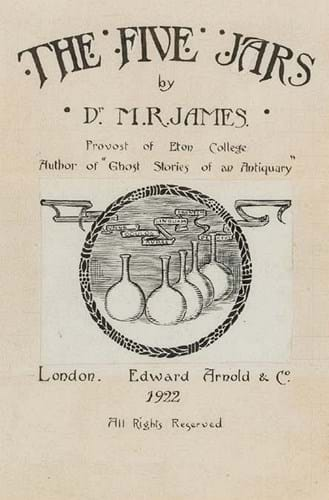
Artwork by James Gilbert for the title-page of MR James’ only novel, The Five Jars of 1922. Here he is named as Dr James, Provost of Eton College, but in the published work both his title and his post were deleted, perhaps because he wished to keep his roles as writer and academic separate. Sold for £850 by Forum.
Record prices
Among modern firsts, copies in good dust jackets of JG Farrell’s first two published novels, both signed and inscribed to his girlfriend of the time, made record prices. Bid to £1800 was A Man from Elsewhere of 1963, a book Farrell came to dislike and which was never reprinted, while The Lung of 1965 realised £1600.
Records were also set for works by Seamus Heaney, with £2800 paid for a 1966 first of Death of a Naturalist inscribed to the artist Norman Todhunter, “To set the darkness echoing”, and £3500 for a special copy of The Tree Clock of 1990.
The latter was one just 20 copies (of an edition of 870) printed on hand-made paper. Uncut and unopened, it was signed and contained an autograph poem by Heaney, ‘The Point’.
The most expensive of the modern firsts was very different, being a rather battered copy of Harry Potter and the Philosopher’s Stone of 1997. The backstrip was coming loose, the spine ends and corners were bumped and rubbed and there were ownership inscriptions on the endpapers.
It nevertheless sold for a treble-estimate £22,000.
Sold for £7000 among the travel books, which also included books from the Cox library, was a rare Jesuit Relation… concerning the order’s missionary work in Canada. Published in Paris in 1637, Paul Le Jeune’s report includes the death of the explorer Champlain and Brébeuf’s account of a mission among the Huron peoples.
A copy of Christopher Middleton’s 1743 Vindication… of his conduct in a voyage made on behalf of the Hudson’s Bay Company in search of a Northwest Passage, the first publication in the famous Middleton-Dobbs controversy, sold at £4000.
The North American/Arctic theme was also reflected in the sale of an SPCK Bible of 1854. It was the one used by Admiral Sir Francis McClintock during a three-year search in the yacht Fox for clues to the fate of the lost Franklin expedition, and was inscribed to that effect.
A collection of watercolours depicting Irish lighthouses and coastal features was noted in ATG No 2337, but the Forum sale also included a 90-lot section devoted wholly to works of Irish interest.
Showing a number of defects and repairs, but clean and bright in a modern binding, a copy of the Dublin landscape painter, Jonathan Fisher’s Scenery of Ireland…, published in 1795 with 60 sepia aquatint plates, made a record £5000.
Also among the topographical works was what may have been the antiquarian and naturalist, Edmund Gatty’s own copy of his Antiquities of Tory Island, extra illustrated with six watercolour or pencil landscape views. Nine miles off the north-west coast of County Donegal, Tory is Ireland’s most remote inhabited island.
Fine Irish bindings were also offered, among them a copy of George Hardiman’s History of the Town and County of Galway of 1820 in a full green morocco gilt binding by George Mullen. It made £3200.
Indecent proposals
Sold at that same sum was a volume that brought together in a single volume a coloured etched plate called Sketch of the Life and Unparalleled Sufferings of James Byrne… and a work called The Bishop!! Particulars of the Charge Against the… Bishop of Clogher, for an Abominable Offence…, both dated 1822.
In 1811 Byrne, coachman to John Jocelyn, had acused his employer’s brother, Percy, Bishop of Clogher, of “taking indecent familiarities” and of “using indecent or obscene conversations with him”.
Byrne was sued for criminal libel by the cleric and on conviction was sentenced to two years in jail and a public flogging. By recanting his allegations at the prompting of the bishop’s agent, he avoided the flogging, but then in 1822 the bishop was caught in a homosexual act with a John Movelly of the Foot Guards in a London public house.
Deprived of his see, the clergyman fled to Scotland, where he worked as a butler for the rest of his life.


